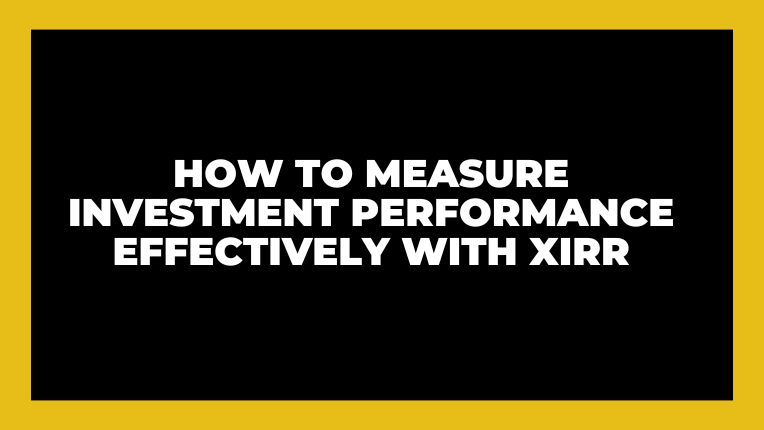Imagine this: you've been diligently investing ₹5,000 every month in a mutual fund SIP. Some months you add a little extra, maybe ₹10,000 as a top-up. One year, you redeem a small portion for an emergency. After a few years, your fund is worth a lot more.
Now comes the big question: "How do I measure the actual return I've earned?"
If you simply look at the total amount invested versus the final value, you'll only get a rough idea. If you use CAGR, you'll assume all your money was invested in one go, which isn't true in your case. The reality? Your money entered and exited at different times.
This is exactly why investors need XIRR (Extended Internal Rate of Return), a tool that gives you the real picture of your investment performance.
What is XIRR in Simple Words?
Think of XIRR as the storyteller of your investments. Instead of just showing the beginning and the end like CAGR does, it narrates the full journey, like every SIP, every withdrawal, every dividend, and exactly when they happened.
- XIRR (Extended Internal Rate of Return) calculates the annualized rate of return for investments with irregular cash flows.
- It works beautifully for SIPs, mutual funds, top-ups, or even real estate investments where money goes in and out at different times.
- By considering both the amount and the date of each transaction, you can get a more realistic measure of performance.
In short, if CAGR is a straight line, XIRR is the true path your money actually took.
Why XIRR is a Smarter Choice
Let's break it down:
- CAGR (Compound Annual Growth Rate): Works only if you invest a lump sum once and let it grow.
- XIRR: Perfect when your cash flows are irregular, like SIPs, bonuses added, or partial redemptions.
That's why most mutual fund platforms, financial advisors, and wealth managers rely on XIRR to showcase real returns.
With XIRR, you're not looking at a "theoretical" number; you're seeing your true annualised return.
How Does XIRR Work in Mutual Fund Investments?
Picture your SIPs: every month you invest ₹5,000. Then, one month you top it up with ₹20,000. Another month, you redeem ₹10,000. Finally, after a few years, your portfolio value is ₹4,00,000.
Now, how do you know what you actually earned?
- CAGR will assume you invested one lump sum.
- XIRR, however, will track every entry and exit date and give you a single annualised rate that represents your journey.
This is why XIRR is the gold standard for mutual fund performance — it's precise, personal, and practical.
Step-by-Step: How to Calculate XIRR Easily
You don't need to be a math wizard. Thanks to online tools, it's super simple.
Try the XIRR Calculator by Livelong Wealth to instantly calculate your true returns. Here's how:
- Enter transactions – Input your investment amounts and withdrawals.
- Add dates—Mention when each transaction happened.
- Submit—Click "Calculate" and let the tool do the work.
- Get your XIRR—instantly see your annualized return.
- Use the insight—a higher XIRR means more efficient performance.
No guesswork. Just clarity. Try it now and measure your mutual fund returns the smart way.
XIRR vs. CAGR: Which One Should You Use?
Here's a quick cheat sheet:
- Use CAGR when you invested a single lump sum and want to see growth over time.
- Use XIRR when you have SIPs, irregular deposits, or partial withdrawals.
Rule of thumb:
- Lump sum = CAGR.
- SIPs and irregular flows = XIRR.
Check out our blog: CAGR Calculator: How to Accurately Measure Your Investment Growth
For most modern investors, XIRR is the go-to tool because life (and investments) rarely follows a perfect straight line.
Conclusion: Measure What Truly Matters
When it comes to wealth-building, numbers can sometimes mislead. CAGR might flatter or understate your real returns if you've been investing in bits and pieces. But XIRR? It tells the truth.
At Livelong Wealth, we believe every investor deserves clarity. That's why we've built a free, easy-to-use XIRR Calculator. Whether you're tracking your SIPs, mutual funds, or other investments, it's the simplest way to measure performance accurately.
Stop guessing. Calculate your XIRR today with Livelong Wealth and take smarter investment decisions for tomorrow.
FAQs on XIRR
Q1: Is XIRR only for SIPs?
No. XIRR works for any investment with multiple, irregular cash flows like SIPs, mutual funds, stocks, FD or even real estate.
Q2: Why is XIRR more accurate than CAGR?
Because CAGR assumes a single cash flow, while XIRR considers every inflow and outflow along with its exact date.
Q3: What's a "good" XIRR?
It depends on your investment type and horizon. For equity mutual funds, an XIRR of 10–15% long-term is considered healthy.
Q4: How do I calculate XIRR without Excel?
Simply use the online XIRR Calculator by Livelong Wealth for instant results.
Pro tip: Next time someone asks you, "How much are your SIPs earning?" don't say "around 12% CAGR." Instead, check your XIRR because that's the real story.
Check out our latest blog: CAGR Calculator: How to Accurately Measure Your Investment Growth

